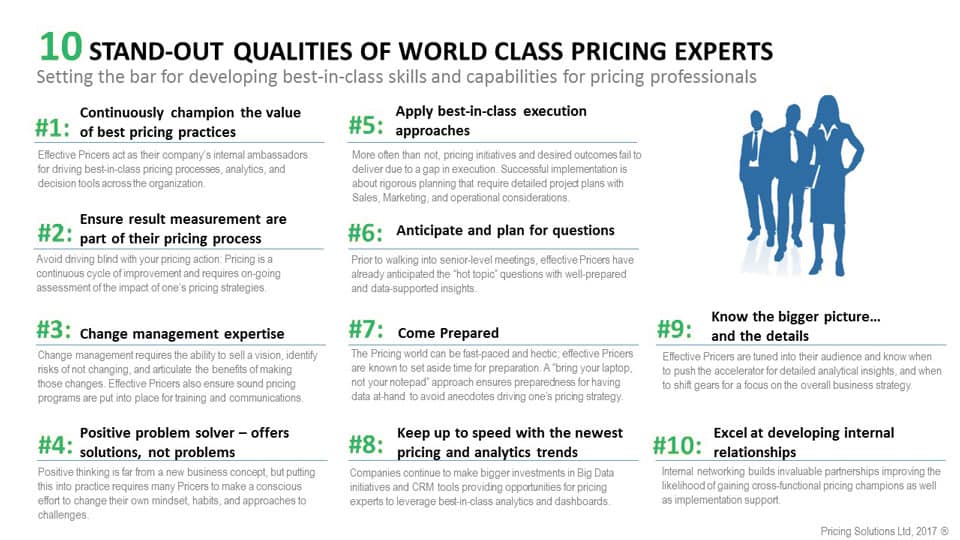Developing best-in-class skills and capabilities for your pricing career
Any professional involved in the pricing discipline knows that pricing involves much more than developing recommendations and price points. Best-in-class pricing professionals have an extremely unique skill set that integrates: pricing know-how, marketing execution, project planning and change management. Those skills are combined with the ability to sell, lead, and deliver pricing transformation initiatives within their own organization.
As a consulting firm Pricing Solutions has witnessed a variety of pricing professionals and teams with a vast range of skills, qualities and capabilities. We compiled 10 stand-out qualities of effective pricing professionals; qualities that are common traits amongst the best pricers and can be used to improve your pricing capabilities.
1. Champion the value of best pricing practices
“Nothing gets me more excited than someone providing a plan on how to make more money” – words spoken from a $1B+ US restaurant chain CEO. Pricing is a powerful lever to improve a company’s bottom line, more so than costs and volume. In an often quoted Harvard Business study by Marn and Rosiello, for a company with average economics, a 1% improvement to pricing increases operating profit by 11% (assuming no loss to volume). Compare this to only a 3.3% increase using a 1% improvement to unit volume. Unfortunately, pricing is often a secondary consideration within many organizations, and it is up to the Pricing Leaders to champion the bottom-line impact of best pricing practices as part of their team’s mandate.
2. Ensure result measurements are part of the pricing process
A client recently mentioned they were part of a company-wide project 20 years that sought to develop customized results measuring dashboards. The project cost at that point was around $10 million. In today’s world, for a similar project, this could be accomplished well within a more reasonable budget for any $5M+ organization. Dashboard solution providers, such as Tableau and Qlikview, have developed platforms that can easily integrate within a company’s IT infrastructure and display powerful result measurement insights – key for any organization that needs to understand the impact of changes to their pricing strategies.
Pricing tools including the price waterfall, price dispersion, customer & product net pocket price, price-volume trends, etc; these can all be developed, distributed, and accessed via a web browser to a larger audience within your organization. If you haven’t already kick-started dashboards as part of your Pricing team’s deliverables, many solutions are available for download as free trials and typically include a wealth of self-taught videos on their websites or YouTube.
3. Be the voice of change
Change management requires the ability to sell a vision, identify the risks of not changing, and articulate the benefits of making those changes. It also ensures that sound programs are put into place for training, communications, and post-launch follow-ups. Sales teams, in particular, need to be prepared for any changes that impact their day-to-day sales activities and customer engagements.
In one particular case, a $1B manufacturer changed their foreign exchange rate policy across Europe resulting in over 20% price increases to some major product lines. The Field Sales Reps were ill-prepared and were quickly overcome by customer objections around these price changes. A sound training program to include objection-handling preparation, role play workshops, and quick reference Sales materials, would have ensured a smoother transition and better preparation for those potentially challenging customer conversations.
4. Offer solutions, not problems
Will Bowen, a US pastor, handed out 250 bracelets to his congregation to remind them to stop complaining and criticizing. He challenged them to stop complaining for 21 days (the time taken to break a habit). Whenever they found themselves failing, they were to switch the bracelet to the other wrist and start over. It was a hit, and the approach quickly went viral. The result? Reduced complaining actually helped offer solutions, not problems. The mindset shifted from “this is terrible” to “this is not the way I would like it to be. This is the way I would like it to be”.
Pricing Leaders often find themselves in a position that easily enables negativity: Daily fire drills, acting as the “police” for deal desk, as well as encountering on-going objections and obstacles in their pricing initiatives – these pain points often create a strenuous work atmosphere and can nurture negativity.
Positive thinking is far from a new concept approach in business, but putting it into practice is a different ball game that requires many Pricers to make a conscious effort to change their own mindset and habits. By and large, Senior Management, peers, and colleagues, also react more favorably to positive thinkers and solution-providers; this also helps develop more respect demonstrating an ability to remain calm under fire.
5. Apply best-in-class execution approaches
More often than not, pricing initiatives fail to deliver the anticipated results because of a gap in execution. Successful execution is about planning across the organization; this can involve detailed cross-functional execution plans. The Pricing function never ends at the Pricing team – countless departments within an organization are impacted by Pricing at some point or another. Some form of ownership to translate those pricing initiatives into action plans across those business units (and go-to market channels) is required to successfully execute a pricing transformation project.
This typically requires developing a strong cadence cycle of project plan reviews with a core cross-functional team highlighting priorities, risks, and critical path obstacles. Meeting minute notes are key to ensure that agreed actions are tracked with follow-ups. As key milestones approach, five to ten minute morning SCRUM sessions can also help to ensure daily priorities address any last minute critical path roadblocks.
6. Anticipate and plan for the questions
Quick test: What was your company’s overall sales and margin results in the previous quarter? Did the company hit or miss their target? What were the results of recent price changes? Was there any negative impact to sales or mix?
In my earlier career, the company’s CEO was notorious for testing his employees on the spot with respect to sales performance. If you weren’t aware of the company’s financial objectives and performance, then you were driving blind not knowing if you are succeeding or failing. Pricing efforts must ultimately tie back to the company and business objectives – knowing those results is key to understanding the overall success of one’s pricing initiatives.
Pricers should also have a best-in-class approach to results measurement. A typical Executive will ask, “How are we performing after those price increases?”; effective Pricers are ready with an answer. Being proactive and ensuring results measurement is part of the pricing process drives a continuous cycle of improvement. Tie this in with automated online results measurement dashboards and you will be in a strong position to “wow” your Senior Management teams.
7. Come prepared
Surprisingly, many Pricers come ill-prepared to meetings. Not preparing in advance results in being reactive to questions. Effective Pricing Professionals come prepared and also ensure they have data and supporting analytics at their fingertips: a “bring your laptop, not your notepad” approach. This habit also ensures meetings and decisions aren’t dominated by Sales anecdotes (which can lead to Extinction by Instinct). Senior Management will often look to Pricing Leaders to provide insights and metrics – not having this data at-hand misses out on an opportunity for Pricers to effectively contribute to those conversations and demonstrate their team’s value.
Pricers can also get bogged down in daily fire-drills and back-to-back meetings; this impacts their ability to be prepared for upcoming meetings. Effective Pricers often make a point to schedule planning time within their calendars to allow themselves time to prepare for upcoming meetings, especially when those meetings include Senior Management or C-Level. Best-in-class preparedness and task prioritization typically begins at the onset of each business day.
8. Keep up-to-speed on the newest pricing and analytic trends
“Times they are a changing” – this is particularly true in the field of analytics, data management, and CRM. In many organizations, Big Data initiatives have now moved from buzzwords to mainstream use. In fact, 62.5% of Fortune 1000 firms reported they now have at least one instance of Big Data in production – double from 31.4% in 2013. This provides newfound opportunities for Pricers to be more effective within their organization.
Companies are also making larger investments in CRM tools and data architecture improvements; this is an opportunity for Pricers to improve their own capabilities around pricing and segmentation analytics. Whether its Big Data solutions, price optimization capabilities, newest pricing management platforms, or even dashboard tools, it is important for Pricers and their teams to stay on top of the newest trends and continue a learning path that strives for developing their level of expertise.
9. Know the bigger picture… and the details
Pricing expertise requires a strong ability to understand data analytics and translate that into actionable business strategies that support business objectives. To sell a pricing recommendation, it is crucial to be able to clearly articulate the strategies and recommendations without locking your audience into Paralysis by Analysis. Effective Pricers are tuned-into their audience and know exactly when to discuss detailed analytics and when they need to focus on the big picture.
A suggestion to avoid the Paralysis by Analysis trap is to pad your appendix with go-to reference analytics material. In the core proposal deliver pricing tactics and strategies that support the company and business objectives –but provide just enough insightful and comprehensible analytics in the appendix to gain support for your recommendations.
10. Develop Strong Internal Relationships
Building sound relationships with your colleagues across departments outside of the usual meetings helps nurture a partnership approach to pricing. Pricing actions require stakeholders, champions, and cross-functional team support – the better your relationships within the organization, the higher the likelihood of success when implementing those programs.
A simple way to improve your internal relationship includes on-going networking – which is particularly important for global organizations. For example, make a point of scheduling one-on-one touch points with colleagues who are in town from their remote or regional locations. Never Eat Alone, is a great read that highlights the importance of mastering your networking skills both inside and outside of business.
Ultimately, effective Pricing Professionals help set the foundation that establishes a company’s development of pricing as a strategic capability. As the profit dollars continue to grow from pricing transformation initiatives, so too will the spotlight on the Pricing team, their best-in-class practices, and their ability to have a positive impact across the organization.
Scott Miller is a Senior Consultant of Pricing Strategy & Marketing Science at Pricing Solutions. An international pricing strategy consultancy dedicated to helping clients achieve World Class Pricing competency.





